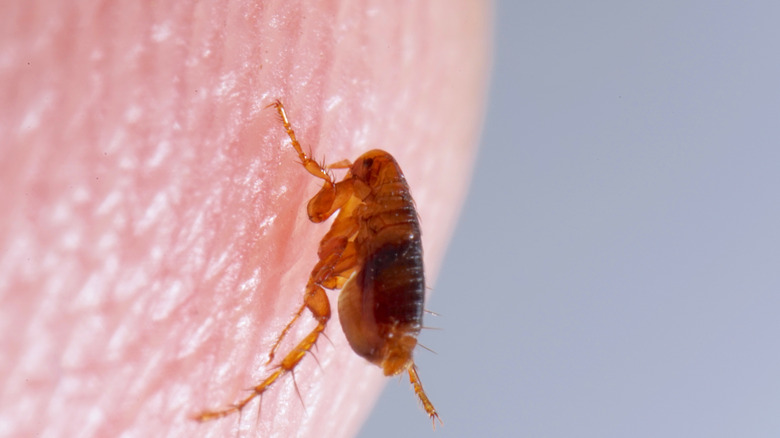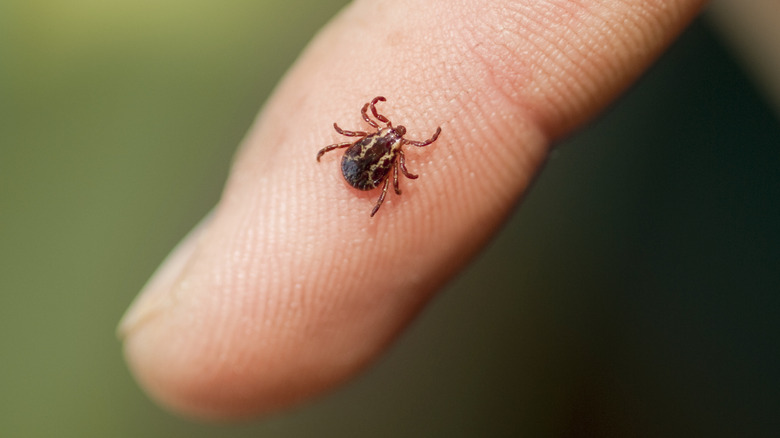Fleas Vs Ticks: How To Determine Which Pest Is Hiding Out In Your Yard
There could be a battle of fleas vs ticks in your lawn happening right now. If your garden, flowerbeds, or lawn has either of these insects present, you may be a bit worried about what steps to take to get rid of them. Your first goal is to identify which of the two you're dealing with, so you can adjust your treatment option accordingly.
Though fleas and ticks are similar in that they are both parasites, fleas tend to be smaller than ticks. Ticks have a visible teardrop shape, while fleas are tiny, often no larger than a black or brown speck. These common pests have other similarities and differences as well, including how they interact with humans, whether or not they bite, and the habitat they prefer (and ultimately infest). The key question many people have, though, is how to get rid of them.
The steps to preventing and removing fleas and ticks from your yard are a bit different, but doing so is necessary in both cases. Though many tick bites are harmless, some ticks can transmit diseases: Deer ticks are known carriers of Lyme disease, per the CDC, a health condition that can cause liver and kidney damage, and a bite from the wood tick can cause an infection of Rocky Mountain spotted fever. Flea bites, via bacteria and germs on their saliva, can also cause illnesses in people, including plague, endemic murine typhus, and cat scratch disease, per the Cleveland Clinic.
How to kill fleas after identifying them
Fleas tend to be very tiny little dots of black that are hard to see and notice until there are a lot of them in one area. Typically, these wingless pests have six legs and sharp claws that allow them to dig in and hold onto their host. They tend to be flatter but can look more rounded when they have been feeding. Fleas have very strong back legs, which allow them to jump as far as a foot at a time, which means they can move through your lawn and toward your home rather easily. Though thousands of species of these critters exist, about 300 different types exist in the U.S., per the Cleveland Clinic.
Fleas don't really seek out people as their host, but instead are looking for a dog, cat, or other type of animal to use as a host. They can lurk in your yard for some time, waiting for a host to come towards them. In order to survive, fleas tend to choose grassy areas with dense patches located under a tree or bush, where there's some level of shade protection. It's difficult to prevent fleas from getting into your yard if you have a lot of local wildlife that could play the role of host. You can use a pre-treatment for fleas on your lawn to help minimize their presence, and chemical-based treatments to get rid of them. Removing thatch from your lawn is also a good idea to minimize their access to hiding spots.
How to kill ticks after identifying them
Ticks can easily be confused with fleas, but several key things make them more complicated to treat. Ticks are wingless insects distinguishable by their black/reddish/brown coloring. The young nymphs are about the size of a grain of salt, while adults are more oval-shaped and as large as a watermelon seed. They plump up when fed recently, and happily bite both humans and animals.
Because ticks live in wooded areas or areas with tall weeds and shrubs, they are commonly found on a person or pet after walking through a forested area or park. You'll also commonly find them near bird nests or in areas where rodents live. However, they can live in your yard, lurking in the brush until a host walks by. Ticks cannot jump, which means they need direct access to a host.
You can pre-treat your yard to keep ticks out of it using an insecticide-based product specifically designed for ticks. Remove any areas where they could lurk, like shrubs that are close to the ground and piles of wood or leaves. It's a good idea to consider a barrier to keep larger animals, like deer, out of your yard. If you find a tick on you or your pet, you'll want to treat the area with pesticides that contain permethrin, per the CDC, and because of the dangers they present, consider a professional pest inspection and treatment.


